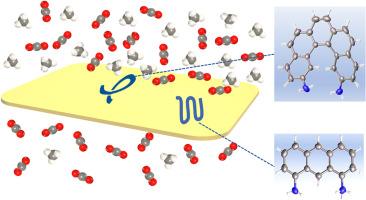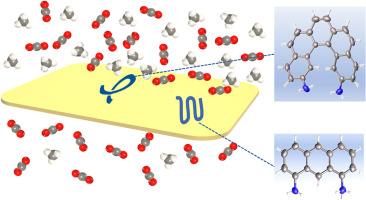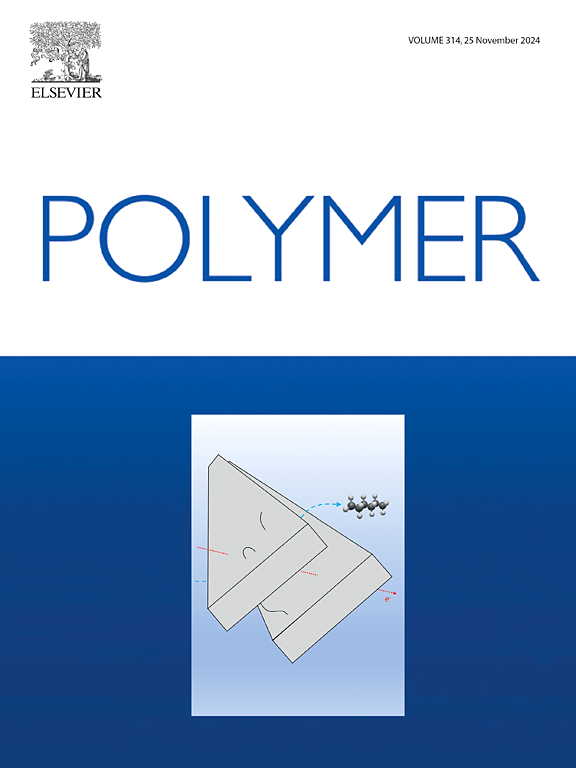Synthesis and characterization of polyimides with rigid folded fragments
IF 4.1
2区 化学
Q2 POLYMER SCIENCE
引用次数: 0
Abstract
The macromolecular chain of conventional polyimide (PI) is a predominant linear extension, which is anticipated to uphold robust interchain interactions essential for preserving overall mechanical and thermal performance. This study is dedicated to the design and synthesis for the novel PIs containing folded chains, with a particular emphasis on modifying the chain conformational behavior with respect to the structure of the aggregation state and the corresponding gas separation properties. First, two unidirectional diamine monomers, dibenzo [c, g] phenanthrene-9,12-diamine (NPDA) and anthracene-1,8-diamine (ADA), were meticulously synthesized through a sequence of chemical reactions, including Witting olefination and photocyclization. These monomers possess distinctive spatial characteristics: NPDA adopts a helical conformation, while ADA maintains a planar structure. Subsequently, the corresponding folded chain-containing PIs, denoted as NPI and API, were successfully achieved by copolymerizing one of the unidirectional monomers with the 6FDA-TPDA system. API and NPI generally exhibit a propensity for enhanced molecular chain stacking, while retaining their good solubility and processability. Drawing from both experimental data and simulation results, it was ascertained that the inclusion of these two monomers produces a rearrangement of pore sizes with a decrease in large-size micropores and an increase in the percentage of ultra-micropores. Moreover, the PI membranes with the folded fragments have a much better CO2 plasticization resistance.


具有刚性折叠片段的聚酰亚胺的合成与表征
传统聚酰亚胺(PI)的大分子链主要是线性延伸,这对保持整体机械和热性能至关重要。本研究致力于设计和合成含有折叠链的新型聚酰亚胺,特别强调在聚合态结构和相应的气体分离性能方面改变链的构象行为。首先,通过一系列化学反应(包括 Witting 烯化和光环化)精心合成了两种单向二胺单体,即二苯并 [c, g] 菲-9,12-二胺(NPDA)和蒽-1,8-二胺(ADA)。这些单体具有独特的空间特性:NPDA 采用螺旋构象,而 ADA 则保持平面结构。随后,通过将其中一种单向单体与 6FDA-TPDA 系统共聚,成功制备出了相应的含折叠链的 PI,分别称为 NPI 和 API。API 和 NPI 在保持良好的溶解性和加工性的同时,还普遍表现出增强分子链堆叠的倾向。根据实验数据和模拟结果可以确定,加入这两种单体后,孔径大小发生了重新排列,大尺寸微孔减少,超微孔比例增加。此外,含有折叠片段的 PI 膜具有更好的抗二氧化碳塑化性能。
本文章由计算机程序翻译,如有差异,请以英文原文为准。
求助全文
约1分钟内获得全文
求助全文
来源期刊

Polymer
化学-高分子科学
CiteScore
7.90
自引率
8.70%
发文量
959
审稿时长
32 days
期刊介绍:
Polymer is an interdisciplinary journal dedicated to publishing innovative and significant advances in Polymer Physics, Chemistry and Technology. We welcome submissions on polymer hybrids, nanocomposites, characterisation and self-assembly. Polymer also publishes work on the technological application of polymers in energy and optoelectronics.
The main scope is covered but not limited to the following core areas:
Polymer Materials
Nanocomposites and hybrid nanomaterials
Polymer blends, films, fibres, networks and porous materials
Physical Characterization
Characterisation, modelling and simulation* of molecular and materials properties in bulk, solution, and thin films
Polymer Engineering
Advanced multiscale processing methods
Polymer Synthesis, Modification and Self-assembly
Including designer polymer architectures, mechanisms and kinetics, and supramolecular polymerization
Technological Applications
Polymers for energy generation and storage
Polymer membranes for separation technology
Polymers for opto- and microelectronics.
 求助内容:
求助内容: 应助结果提醒方式:
应助结果提醒方式:


